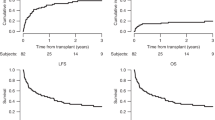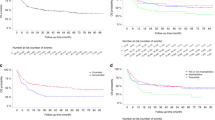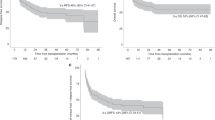Abstract
Haematopoietic SCT (HSCT) offers the only potentially curative option in chronic myelomonocytic leukaemia (CMML). In this study, we report on single-centre results of 18 patients with CMML who have undergone allogeneic HSCT. The median age of patients was 54 years. Seven patients had AML, which had transformed from CMML. Overall, 11 patients received stem cells from an unrelated donor. A total of 15 patients received a T-cell-depleted fludarabine/BU-based reduced-intensity conditioning HSCT. The actuarial 3-year OS, non-relapse mortality (NRM) and relapse incidence for the cohort was 31±11%, 31±14% and 47±13%, respectively. Patients with favourable cytogenetics had a 3-year disease-free survival of 65±17%, whereas none of the seven patients with intermediate or poor risk cytogenetics survived beyond 2 years (P<0.01). No patients with favourable risk cytogenetics died from NRM causes, while the 2-year NRM for the intermediate/poor risk cytogenetics subgroup was 71±22% (P<0.02). In terms of disease status at transplantation, patients who had <5% BM blasts had a 3-year disease-free survival of 46.9±19% compared with those with >5% blasts at the time of transplantation (that is, 20.0±13%). Recipient age, type of conditioning regimen or stem cell dose did not have a significant impact on overall outcomes. Our data support existing evidence that allogeneic HSCT is a feasible therapeutic option for CMML, with the ability to attain long-term remission among patient subgroups.
This is a preview of subscription content, access via your institution
Access options
Subscribe to this journal
Receive 12 print issues and online access
$259.00 per year
only $21.58 per issue
Buy this article
- Purchase on Springer Link
- Instant access to full article PDF
Prices may be subject to local taxes which are calculated during checkout


Similar content being viewed by others
References
Jaffe EHN, Stein H, Vardiman JW . World Health Organisation classification of tumours, pathology and genetics of tumours of haematopoietic and lymphoid tissues. In: Jaffe EHN, Stein H, Vardiman JW (eds). IARC Press: Lyon, France, 2001.
Onida F, Kantarjian HM, Smith TL, Ball G, Keating MJ, Estey EH et al. Prognostic factors and scoring systems in chronic myelomonocytic leukaemia: a retrospective analysis of 213 patients. Blood 2002; 99: 840–849.
Benesch M, Deeg J . Haemopoietic cell transplantation for adult patients with myelodysplastic syndromes and myeloproliferative disorders. Mayo Clin Proc 2003; 78: 981–990.
Kröger N, Zabelina T, Guardiola P, Runde V, Sierra J, Van Biezen A et al. Allogeneic stem cell transplantation of adult CMML: a report on behalf of the Chronic Leukaemia Working Party of the European Group for Blood and Marrow Transplantation (EBMT). Br J Haematol 2002; 118: 67–73.
Ho AY, Pagliuca A, Kenyon M, Parker JE, Mijovic A, Devereux S et al. Reduced-intensity allogeneic hematopoietic stem cell transplantation for myelodysplastic syndrome and acute myeloid leukemia with multilineage dysplasia using fludarabine, busulphan, and alemtuzumab (FBC) conditioning. Blood 2004; 104: 1616–1623.
Lim ZY, Ho AY, Ingram W, Kenyon M, Pearce L, Czepulkowski B et al. Outcomes of alemtuzumab-based reduced intensity conditioning stem cell transplantation using unrelated donors for myelodysplastic syndromes. Br J Haematol 2006; 135: 201–209.
Lim ZY, Pearce L, Ho AY, Barber L, Ingram W, Usai M et al. Delayed attainment of full donor chimaerism following alemtuzumab-based reduced-intensity conditioning haematopoeitic stem cell transplantation for acute myeloid leukaemia and myelodysplastic syndromes is associated with improved outcomes. Br J Haematol 2007; 138: 517–526.
Sullivan KM, Agura E, Anasetti C, Appelbaum F, Badger C, Bearman S et al. Chronic graft versus host disease and other late complications of bone marrow transplantation. Semin Hematol 1991; 28: 250–259.
Sullivan KM . Graft versus host disease. In: Thomas ED, Blume KG, Forman SJ, (eds). Hematopoietic Cell Transplantation. Blackwell Sciences: Malden, MA, 1999, 515–536.
Greenberg P, Cox C, LeBeau MM, Fenaux P, Morel P, Sanz G et al. International scoring system for evaluating prognosis in myelodysplastic syndromes. Blood 1997; 89: 2079–2088.
Elliott MA, Tefferi A, Hogan WJ, Letendre L, Gastineau DA, Ansell SM et al. Allogeneic stem cell transplantation and donor lymphocyte infusions for chronic myelomonocytic leukaemia. Bone Marrow Transplant 2006; 37: 1003–1008.
Ocheni S, Kröger N, Zabelina T, Zander AR, Bacher U . Outome of allo-SCT for chronic myelomonocytic leukaemia. Bone Marrow Transplant 2009; 43: 659–661.
Author information
Authors and Affiliations
Corresponding author
Ethics declarations
Competing interests
The authors declare no conflict of interest.
Rights and permissions
About this article
Cite this article
Krishnamurthy, P., Lim, Z., Nagi, W. et al. Allogeneic haematopoietic SCT for chronic myelomonocytic leukaemia: a single-centre experience. Bone Marrow Transplant 45, 1502–1507 (2010). https://doi.org/10.1038/bmt.2009.375
Received:
Revised:
Accepted:
Published:
Issue Date:
DOI: https://doi.org/10.1038/bmt.2009.375
Keywords
This article is cited by
-
High EASIX score is an independent predictor of non-relapse mortality in patients with CMML undergoing allogeneic stem cell transplant
Bone Marrow Transplantation (2022)
-
Effective drug treatment identified by in vivo screening in a transplantable patient-derived xenograft model of chronic myelomonocytic leukemia
Leukemia (2020)
-
High leukemia-free survival after TBI-based conditioning and mycophenolate mofetil-containing immunosuppression in patients allografted for chronic myelomonocytic leukemia: a single-center experience
Annals of Hematology (2020)
-
Chronic Myelomonocytic Leukemia: 2018 Update to Prognosis and Treatment
Current Hematologic Malignancy Reports (2019)
-
Therapy for Chronic Myelomonocytic Leukemia in a New Era
Current Hematologic Malignancy Reports (2017)



